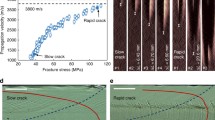Abstract
We have performed a combined experimental and analytical study of cleavage in mica using a double cantilever beam geometry in which a crack induced by a wedge driven into one side of the specimen interacts with a pre-existing, coplanar, internal crack. The internal crack is produced by inserting a fiber into the sample on the cleavage plane. As the wedge-driven crack approaches the internal crack, its growth is retarded by the defect, producing an increase in the apparent fracture resistance. With continued loading, the two cracks coalesce. The experiment has been analyzed using a cohesive zone approach to represent the interlayer adhesion in mica. Analysis of the various stages of the experiment reveal scaling dependencies of the different cohesive zone parameters. The coalescence event has been found to depend on parameters other than the fracture resistance of the interface, making it useful for determining additional parameters in the cohesive description, such as the characteristic opening to failure or the cohesive stress. Analysis of the coalescence event is reproduced with finite element calculations. The interaction experiment allows multiple parameters to be determined in a single experiment using a single sample. In our experiments, we observe an increase in the apparent fracture resistance without introducing additional mechanisms for dissipation. Our results reveal the nature of this pinning mechanism and its strength in terms of cohesive fracture parameters.
Similar content being viewed by others
References
Bailey, A. and Kay, S. (1967). A direct measurement of the influence of vapour, of liquid, and of oriented monolayers on the interfacial energy of mica. Proceedings of the Royal Society of London A301, 1464.
Barenblatt, G. (1959). The formation of equilibrium cracks during brittle fracture: general ideas and hypotheses, axially symmetric cracks. Applied Mathematics and Mechanics (PMM) 23, 622–636.
Bryant, P., Taylor, L. and Guthshall, P. (1963). Cleavage studies of lamellar solids in various gas environments. In: Transactions of the 10th National Vacuum Symposium.
Dugdale, D. (1960). Yielding of steel sheets containing slits. Journal of the Mechanics and Physics of Solids 8, 100–104.
Keegstra, P. (1976). A transient finite element crack propagation method for nuclear pressure vessels steels. Journal of the Institution of Nuclear Engineers 17, 89–96.
Klein, P., Foulk, J., Chen, E., Wimmer, S. and Gao, H. (2001). Physics-based modeling of brittle fracture: cohesive formulations and the application of meshfree methods. Theoretical and Applied Fracture Mechanics 37, 99– 166.
Kobayashi, A., Emery, A. and Mall, S. (1976). Dynamic finite element and photoelastic analyses of two fracture Homalite-100 plates. Experimental Mechanics 16, 321–328.
Lawn, B. (1993). Fracture of Brittle Solids. 2nd ed., Cambridge University Press, Cambridge.
McNeil, L. and Grimsditch, M. (1993). Elastic moduli of muscovite mica. Journal of Physics: Condensed Matter 5, 1681–1690.
Obreimoff, J.. (1930). The splitting strength of mica. Proceedings of The Royal Society of London A215, 905.
Ortiz, M. and Suresh, S. (1993). Statistical properties of residual stresses and intergranular fracture in ceramic materials. Journal of Applied Mechanics 60, 77–84.
Prandtl, L. (1933). GeEin Gedankenmodell für den Zerreiβvorgang spröder Körper. Zeitschrift für angewandte Mathematik und Mechanik 13, 129–133.
Rahul-Kumar, P., Jagota, A., Bennison, S. and Saigal, S. (2000). Cohesive modeling of viscoelastic fracture: application to peel testing of polymers. International Journal of Solids and Structures 37, 1873–1897.
Rice, J. (1968). Mathematical analysis in the mechanics of fracture. In: Fracture: An Advanced Treatise (edited by H. Liebowitz), Vol. 2. New York, Academic Press, pp. 191–311.
Rydholm, G., Fredriksson, B. and Nilsson, F. (1978). Numerical investigation of rapid crack propagation. In: Numerical Methods in Fracture Mechanics (edited by Luxmoore, A. and Owen, D.), pp. 660–672, Pineridge Press.
Wan, K., Lathabai, S. and Lawn, B. (1990), Crack velocity functions and thresholds in brittle solids. Journal of the European Ceramic Society 6, 259–268.
Wan, K. and Lawn, B. (1992). Effect of chemical interaction on Barenblatt crack profiles in brittle solids. Acta Metallurgica et Materialia 40, 3331–3337.
Wan, K., Lawn, B. and Horn, R. (1992). Repulsive interaction between coplanar cracks in the double-cantilever geometry. Journal of Materials Research 7, 1584–1588.
Willis, J. (1967). A comparison of the fracture criteria of Griffith and Barenblatt. Journal of the Mechanics and Physics of Solids 15, 151–162.
Xu, X.-P. and Needleman, A. (1994). Numerical simulations of fast crack growth in brittle solids. Journal of the Mechanics and Physics of Solids 42, 1397–1434.
Xu, X.-P. and Needleman, A. (1996). Numerical simulations of crack growth along an interface. International Journal of Fracture 74, 289–324
Author information
Authors and Affiliations
Rights and permissions
About this article
Cite this article
Hill, J., Bennison, S., Klein, P. et al. Co-planar crack interaction in cleaved mica. International Journal of Fracture 119, 365–386 (2003). https://doi.org/10.1023/A:1024975728664
Issue Date:
DOI: https://doi.org/10.1023/A:1024975728664




